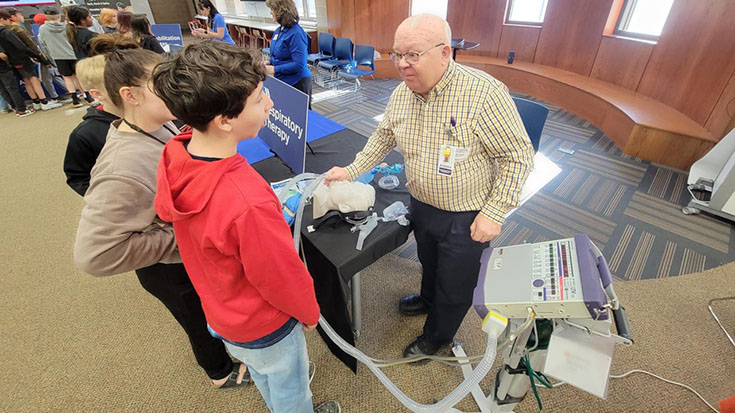
Emergency departments live up to their name — they truly are places of last resort for patients suffering from everything from severe asthma attacks to life-threatening injuries.
Respiratory therapists are part of the team and they must remain calm under pressure.
Chaos is common
As a respiratory therapist at Mercy Medical Center in Springfield, MA, Fams Taal, BSRT, RRT, RRT-ACCS, is often scheduled to work in his Level II ED and he says things can get fairly chaotic, especially during winter when flu season is at its peak.
“When things get hectic for me, I try working with the nurses in triaging to prioritize who needs me first,” he said. “And when things get overwhelming, I reach out to my colleagues for backup help, whether it is for an intubation, noninvasive therapies, or aerosolized medication therapies.”
He returns the favor too — sometimes when he is not even scheduled to work in the ED that day.
“Since we rotate in the ER, I am not always there; however, a member of my team is always there — obviously — so I try to remember and offer support as my floor or ICU therapies allow,” Taal said.
He recalls one instance when he had to jump in: “My coworker was swamped between Bipap, high flow, and intubation with neb treatments left and right. I was happy to come to his rescue by taking over some of that chaotic workload.”
Taal makes it a point to keep his own health in mind during these especially busy days as well, knowing that if he is not up to par physically, his work and his patients may suffer.
“I try to remember to take water breaks as often as my busy ER schedule allows, which helps me remain calm and collective in giving the best care possible,” Taal said.
Steady as she goes
Rena Laliberte, BS, RRT, has been the respiratory therapy ER coordinator at Henry Ford Hospital in Detroit, MI, for many years now, and if she’s learned anything over her time in the position, it’s how to remain on an even keel when the unit gets busy.
That’s not always so easy.
“Working in a level one trauma center we see over 300 patients per day and have the potential to have multiple trauma patients arrive simultaneously,” Laliberte said.
She recalls one day recently when six patients showed up at the same time.
“A truck driver had run into a bus stop, injuring several people, one fatally,” she explained. “We have two trauma bays, so two of the patients went there; the others were taken to different areas in our ED.”
Their injuries were severe and ran the gamut. The surgical team came down as soon as the call went out on the overhead.
“I was able to listen and paid close attention to who was where and how they were triaged,” Laliberte said. “We kept good communication, and when teams arrived, we were able to direct them to the correct patients and locations so they could quickly assess the severity of the injuries.”
Thanks to those calm and collected heads, all the patients got what they needed, when they needed it.
“What initially was very chaotic when all the injured patients arrived at once turned into an organized, calm situation with everyone able to handle their role and care of the patients without stress or loss of precious time,” Laliberte said.
Three great tips
How can you stay calm and move on in your busy ED? Laliberte has these three tips from her many years of experience —
KNOW YOUR STUFF: Being up to date and well educated on evidence-based practice is key. The ED physicians trust my judgment and my actions with all invasive and noninvasively ventilated patients. Once the decision is made for one or the other, those patients are titrated and weaned by RT and discussed with physicians. We do all of our own follow-up, blood gases, x-ray review, etc. This is very time saving for the doctors and nurses who are caring for other patients. By the time the patients arrive on unit, the weaning process has begun. Also, NPPV patients have been aggressively treated by us and usually end up on the general patient unit or discharged to home. (Most cost effective!)
BE STOCKED AND READY: Our ED equipment room has all the essential equipment, and then some. At the start of the shift, I make sure that all stock is replenished for any patient we may encounter. There is nothing worse than having eight vents running at a time and you run out of something you desperately need. It wastes precious moments when you urgently need a peep valve and have to run up five floors to get one.
KNOW YOUR STAFF AND MAKE SURE THEY KNOW YOU: When you know your stuff, are always prepared, and can function without being “told” every single thing, you become a very valuable member of the health care team. Help your team members out when it is super busy, and they will return the favor. If I am running around keeping up with things, staff notices and offers to help me catch up.
Email newsroom@aarc.org with questions or comments, we’d love to hear from you.














